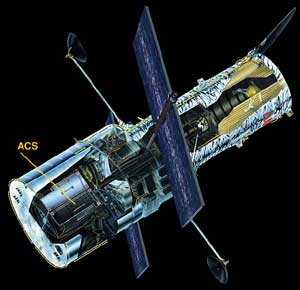 Not for a lack of competition from a certain astronaut who shall not be named, the biggest news of the last couple weeks in the astronomy community has been the tragic loss of the Advanced Camera for Surveys on Hubble Space Telescope. For those of you who haven't heard, the most important camera on the telescope blew a fuse and is out of commission. At least we're left with one saving grace: Next to the description of the failure on NASA’s Hubble web site is another article on repairs and new instruments planned for the next servicing mission – 18 months from now.
Not for a lack of competition from a certain astronaut who shall not be named, the biggest news of the last couple weeks in the astronomy community has been the tragic loss of the Advanced Camera for Surveys on Hubble Space Telescope. For those of you who haven't heard, the most important camera on the telescope blew a fuse and is out of commission. At least we're left with one saving grace: Next to the description of the failure on NASA’s Hubble web site is another article on repairs and new instruments planned for the next servicing mission – 18 months from now.
For my research group in Berkeley, the timing couldn't have been more ironic or more frustrating. We had spent the last two weeks putting together a very large proposal to use this instrument. We were applying for time on the telescope to look for distant supernovae. The proposal was due Friday, Jan. 26, and the very next day the camera had a short circuit. We all decided to then head for happy hour to drown our tears at Triple Rock Brewery.
The Advanced Camera for Surveys was the most widely used of three cameras on Hubble. This camera was used to observe faint distant objects with very high resolution in the same wavelengths that are visible to the eye. The entire image from the camera covered 3 arcminutes on a side, which is about the size of a baseball when viewed from the far end of a football field. This camera served as an upgrade to the still functional camera referred to as WFC2 (affectionately known as wiff-pic), which is much older technology, smaller in size, and significantly degraded since being installed in 1994. The third camera is NICMOS, which takes images of objects in infrared wavelengths, kind of like night-vision goggles. This camera has served as a nice, albeit smaller, complement to the Advanced Camera for Surveys.
The emotions at the lab ran high last week, and I know it’s hard to get physicists to show their emotion, period. It is unfortunate that there are many projects that will have to now go on hold, and others that we can now look to as the trophies of good science data of an instrument that once was. Here’s just a few I know about from my colleagues and neighbors just in Northern California (there are hundreds of examples out there…):
- Weidong Li – UC Berkeley, Imaging of relatively nearby (few hundred million light years away!) supernovae and the environments of the host galaxies
- Adam Stanford – UC Davis, obtaining colors and shapes of very distant clustered galaxies to study the way the largest structures formed almost ten billion years ago
- Paul Kalas – UC Berkeley, imaging scattered light around nearby stars from disks of debris which may contain underlying planetary systems
These projects are nearly impossible with any instruments available from the ground. At this point, researchers will have to settle for less ambitious science goals and swallow the bitter pill that this camera is in fact gone forever. And its replacement is very far off on the horizon (18 months is many more than 10 dog years up at the Lab). So until then, we will make the best of the data we have, and hope that our community can avoid any more news about diapers.
